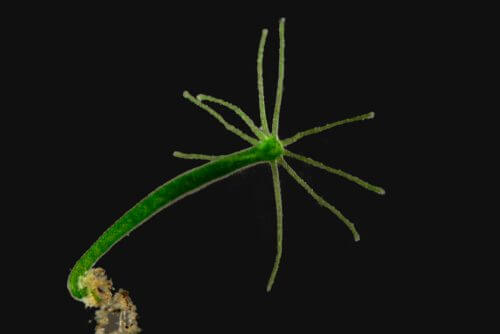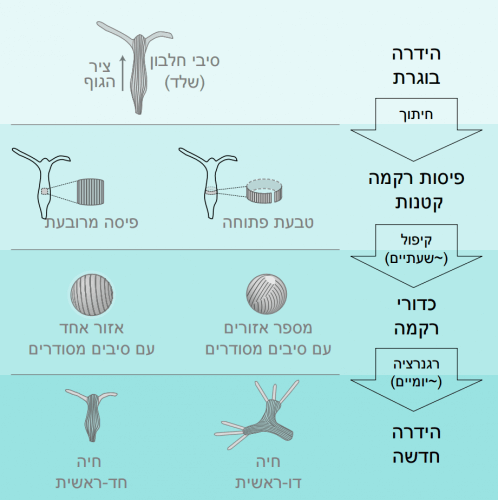Researchers at the Faculty of Physics at the Technion present a new explanation for the hydra's rare ability to regenerate

The hydra is a tiny predator - about 10 millimeters long - that lives in fresh water and hunts its prey with arms that surround its mouth. Since the 18th century, the hydra has fascinated many scientists around the world due to its rare regeneration skills - its ability to regenerate into a whole creature from small pieces of tissue or clusters of cells. Because of this, it is named after the mythological hydra - a many-headed monster that grows a new head every time one of its heads is cut off.
The hydra's ability to regenerate itself from a piece of tissue severed from its body has, until now, been explained by chemical signals giving the tissue sufficient clues as to where it should grow a head, arms and legs. However, a new explanation, published this week in the journal Cell Reports, links the hydra's ability to regenerate to a "structural mechanical memory" present in its body cells. The research was conducted at the Technion Physics Faculty by Prof. Kinneret Keren, Prof. Erez Brown and the research students Anton Liebshitz, Lital Shani-Zerbiv and Yonit Merods-Zachs.
Prof. Keren, a biophysicist who joined the Technion faculty in 2008, explains that "the central discovery in the current study is that structural mechanical memory, the discovery of which emphasizes the importance of mechanical processes in the regeneration process. This memory, which helps the hydra regenerate and become a whole and functioning creature again, is actually a pattern of mechanical force found in thin protein fibers that make up the cytoskeleton. When a piece of tissue is severed from the hydra's body, this skeleton of protein fibers survives and instructs the cells how to arrange themselves to produce the morphology of an adult hydra."
A piece of tissue cut from the hydra's body is first folded into a small ball. This process distorts the protein fibers and forces them to find a balance between preserving the skeleton of the old structure and adapting to the folded shape that was created. The new body parts develop based on the template stored in the skeleton: the spherical tissue develops into a cylinder and grows a mouth surrounded by arms, and eventually a complete hydra is obtained with all the missing body parts.

The Technion researchers discovered that a deliberate disruption of the skeletal structure is sufficient to disrupt the morphology of the regenerated hydra. In one of the experiments, tissue from an adult hydra was cut into rings. After the rings were folded into a ball, the tissue contained several areas of fibers arranged in different directions due to the geometric constraint of the folding. The result: development of Hydra Two Prime. However, when the researchers anchored these tissue rings to stiff, thin metal wires, a normal hydra evolved, First of all. The researchers' conclusion is that the mechanical feedback present in the tissue encourages the formation of order in the developing animal.
"Hydra are simpler creatures than most of their relatives in the animal kingdom," says Prof. Keren, "but the basic pattern of arranged skeletal fibers is also common in many organs of the human body - muscles, heart and intestines - and in certain tissues such as skin and hair that undergo regeneration processes. Similar mechanisms operate in the development process of many creatures from the embryonic stage to the adult animal. Therefore, an in-depth understanding of the regeneration processes in Hydra may shed light on the mechanical mechanisms involved, alongside the biochemical signals, in the processes of biological development."
For the full study in the journal Cell reports
Watch: A two-headed hydra grows next to a one-headed hydra. The thread running through the single-headed hydra helps stabilize growth along a single axis
Another video: Hydra regeneration, from the ball stage to full development

One response
#Compiodot
Stunning